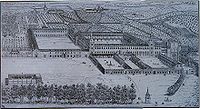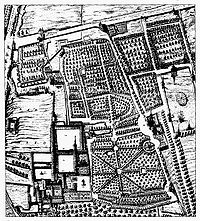
Buen Retiro Palace
Encyclopedia




Madrid
Madrid is the capital and largest city of Spain. The population of the city is roughly 3.3 million and the entire population of the Madrid metropolitan area is calculated to be 6.271 million. It is the third largest city in the European Union, after London and Berlin, and its metropolitan...
was a large palace complex designed by the architect Alonso Carbonell (c. 1590–1660) and built on the orders of Philip IV of Spain
Philip IV of Spain
Philip IV was King of Spain between 1621 and 1665, sovereign of the Spanish Netherlands, and King of Portugal until 1640...
as a secondary residence and place of recreation (hence its name). It was built in what was then the eastern limits of the city of Madrid. Today what little remains of its buildings and gardens forms the Retiro Park
Parque del Buen Retiro
The Buen Retiro Park is the largest park of the city of Madrid, Spain...
.
History
Philip IVPhilip IV of Spain
Philip IV was King of Spain between 1621 and 1665, sovereign of the Spanish Netherlands, and King of Portugal until 1640...
used to stay occasionally in some rooms annexed to the monastery of San Jerónimo el Real
San Jerónimo el Real
San Jerónimo el Real is a Roman Catholic church from the early 16th-century in central Madrid .The church, which has undergone numerous remodelings and restorations over the centuries is the remaining structure of the Hieronymite monastery that once stood beside the royal palace of Buen Retiro, of...
(close to the current location of the Prado Museum, which received the name of the Royal Quarters. The reason for these frequent visits could be that the so-called Planet King particularly enjoyed walking in the attached farm, property of the Count-Duke of Olivares
Gaspar de Guzmán, Count-Duke of Olivares
Don Gaspar de Guzmán y Pimentel Ribera y Velasco de Tovar, Count-Duke of Olivares and Duke of San Lúcar la Mayor , was a Spanish royal favourite of Philip IV and minister. As prime minister from 1621 to 1643, he over-exerted Spain in foreign affairs and unsuccessfully attempted domestic reform...
, his royal favourite and minister.
Olivares, with the intention of pleasing the monarch, planned in 1629 and started in 1630 the construction of a series of offices and pavilions as an extension of the Royal Quarters, which ended up forming the Buen Retiro Palace. The building of the palace was not something planned from the start, but occurred over a period of seven years (until 1640 during which further additions were built successively). Once finished, the palace consisted of more than 20 buildings and two large open squares used for court entertainments and various other acts. The palace complex was surrounded by a large expanse of gardens and ponds, giving it a playful character.
The king only used to spend a few days per year, usually in the summer, in his second home, but a large campaign was still carried out to provide the palace with an artistic ornamental level that would match that of the Royal Alcazar of Madrid
Royal Alcazar of Madrid
The Royal Alcázar of Madrid was a Muslim fortress built in the second half of the 9th century, at the site of today's Royal Palace of Madrid, Madrid, Spain. The structure was extended and enlarged over the centuries, particularly after the 16th century...
, his main residence. The lack of antique paintings in the market led to the commission of a series of paintings from Rome
Rome
Rome is the capital of Italy and the country's largest and most populated city and comune, with over 2.7 million residents in . The city is located in the central-western portion of the Italian Peninsula, on the Tiber River within the Lazio region of Italy.Rome's history spans two and a half...
and Naples
Naples
Naples is a city in Southern Italy, situated on the country's west coast by the Gulf of Naples. Lying between two notable volcanic regions, Mount Vesuvius and the Phlegraean Fields, it is the capital of the region of Campania and of the province of Naples...
, which required the management of ambassadors and others of Philip IV's workers. Several of these pictures remain in the Prado Museum; some highlights are the landscapes of Claude Lorrain
Claude Lorrain
Claude Lorrain, , traditionally just Claude in English Claude Lorrain, , traditionally just Claude in English (also Claude Gellée, his real name, or in French Claude Gellée, , dit le Lorrain) Claude Lorrain, , traditionally just Claude in English (also Claude Gellée, his real name, or in French...
, Nicolas Poussin
Nicolas Poussin
Nicolas Poussin was a French painter in the classical style. His work predominantly features clarity, logic, and order, and favors line over color. His work serves as an alternative to the dominant Baroque style of the 17th century...
and Gaspard Dughet
Gaspard Dughet
Gaspard Dughet , also known as Gaspard Poussin, was a French painter born in Rome.A pupil of Nicolas Poussin, Gaspard Dughet was the brother of Poussin's wife...
, Biblical and mythological scenes by Massimo Stanzione
Massimo Stanzione
Massimo Stanzione was an Italian Baroque painter, mainly active in Naples.Massimo Stanzione was an Italian Baroque painter. Born in Naples in 1586, Massimo was greatly influenced by Michelangelo Merisi da Caravaggio, but what earned him the nickname of The Neapolitan Guido Reni was his...
and several paintings of ancient Rome by Giovanni Lanfranco
Giovanni Lanfranco
Giovanni Lanfranco was an Italian painter of the Baroque period.-Biography:Giovanni Gaspare Lanfranco was born in Parma, the third son of Stefano and Cornelia Lanfranchi, and was placed as a page in the household of Count Orazio Scotti...
, among other artists.
For the Salón de Reinos
Salón de Reinos
The Salón de Reinos or salón grande is a wing of the palacio del Buen Retiro in Madrid. Built between 1630 and 1635, it housed the largest paintings in the royal collection, now all in the Museo Nacional del Prado...
(royal reception room; until recently the Army Museum) a commemorative series of Spanish military triumphs was commissioned, including Diego Velázquez
Diego Velázquez
Diego Rodríguez de Silva y Velázquez was a Spanish painter who was the leading artist in the court of King Philip IV. He was an individualistic artist of the contemporary Baroque period, important as a portrait artist...
' famous painting The Surrender of Breda
The Surrender of Breda
La rendición de Breda , also known as El cuadro de las lanzas or Las lanzas, is a painting by Velázquez, painted during the years 1634–35, and inspired while Velázquez was visiting Italy with Ambrosio Spinola, the Italian general who conquered Breda on June 5, 1625. It is considered one of...
. Other paintings of the series are due to Francisco Zurbarán
Francisco Zurbarán
Francisco de Zurbarán was a Spanish painter. He is known primarily for his religious paintings depicting monks, nuns, and martyrs, and for his still-lifes...
, Antonio de Pereda
Antonio de Pereda
Antonio de Pereda was a Spanish Baroque-era painter, best known for his still lifes. Pereda was born in Valladolid. He was the eldest of three brothers from an artistic family. His father, mother and two brothers were all painters. He was educated in Madrid by Pedro de las Cuevas and was taken...
, Juan Bautista Maíno and Vicente Carducho.
The palace remained a royal residence until the late 18th century. After the fire of the Royal Alcazar of Madrid
Royal Alcazar of Madrid
The Royal Alcázar of Madrid was a Muslim fortress built in the second half of the 9th century, at the site of today's Royal Palace of Madrid, Madrid, Spain. The structure was extended and enlarged over the centuries, particularly after the 16th century...
in December 1734, the Buen Retiro Palace became the main seat of the royal court until the construction of the new Royal Palace of Madrid
Royal Palace of Madrid
The Palacio Real de Madrid is the official residence of the King of Spain in the city of Madrid, but it is only used for state ceremonies. King Juan Carlos and the Royal Family do not reside in the palace, choosing instead the more modest Palacio de la Zarzuela on the outskirts of Madrid...
, which was finished in 1764.
Due to its hasty design and construction, the building of the palace was low-quality, including the materials used, and this was the cause of its end. During the Peninsular War
Peninsular War
The Peninsular War was a war between France and the allied powers of Spain, the United Kingdom, and Portugal for control of the Iberian Peninsula during the Napoleonic Wars. The war began when French and Spanish armies crossed Spain and invaded Portugal in 1807. Then, in 1808, France turned on its...
, in 1808 French troops stationed in Madrid used the palace and its annexes as barracks. Powder kegs were stored in the gardens and a bunker was built for them, causing irreparable damage to the area. Furthermore, the buildings were seriously damaged, so much so that when Isabella II
Isabella II of Spain
Isabella II was the only female monarch of Spain in modern times. She came to the throne as an infant, but her succession was disputed by the Carlists, who refused to recognise a female sovereign, leading to the Carlist Wars. After a troubled reign, she was deposed in the Glorious Revolution of...
tried to begin its restoration, it was decided that nothing could be done but to demolish it almost totally.
Today
The main remaining trace of the Palace complex is the gardens of Retiro Park, although these have no resemblance to the original design of the gardens, and encompass only half the original extension. Two other buildings remain, much altered from their original exteriors, both now destined to become part of the Prado Museum complex:- The Salón de ReinosSalón de ReinosThe Salón de Reinos or salón grande is a wing of the palacio del Buen Retiro in Madrid. Built between 1630 and 1635, it housed the largest paintings in the royal collection, now all in the Museo Nacional del Prado...
(originally the royal reception room), which for decades has housed the Museo del Ejército (Army Museum), that is now due to move to the Alcázar de Toledo in 2010–12.
- The Salón de Baile (originally the ballroom), now known as the Casón del Buen Retiro, once housing the 19th century Prado collections, now hosts the Study Center of the Prado Museum. The ceiling of the main room is decorated by a magnificent fresco by the Italian artist Luca GiordanoLuca GiordanoLuca Giordano was an Italian late Baroque painter and printmaker in etching. Fluent and decorative, he worked successfully in Naples and Rome, Florence and Venice, before spending a decade in Spain....
, painted around 1696–1697 for King Charles II of SpainCharles II of SpainCharles II was the last Habsburg King of Spain and the ruler of large parts of Italy, the Spanish territories in the Southern Low Countries, and Spain's overseas Empire, stretching from the Americas to the Spanish East Indies...
and depicting The Apotheosis of the Spanish Monarchy.

